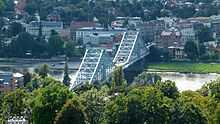Blue Wonder
| Blue Wonder Blaues Wunder | |
|---|---|
 Blue Wonder, spanning the Elbe River | |
| Carries | Motor vehicles (up to 15 tonnes), trams (until 1985), pedestrians and bicycles |
| Crosses | Elbe |
| Locale | Dresden (Blasewitz–Loschwitz) |
| Official name |
Loschwitzer Brücke König-Albert-Brücke (until 1912) |
| Maintained by | Straßen- und Tiefbauamt Dresden |
| Characteristics | |
| Design | Cantilever |
| Total length | 280 metres (920 ft) |
| Width | 12 metres (39 ft) |
| Longest span | 146 metres (479 ft) |
| History | |
| Designer |
Claus Koepcke Hans Manfred Krüger |
| Opened | July 15, 1893 |
| Statistics | |
| Toll | free since 1923 |
Blue Wonder (German: Blaues Wunder) is the commonly used name for the Loschwitz Bridge (Loschwitzer Brücke), a cantilever truss bridge over the Elbe river in the Saxon capital of Dresden, Germany. It connects the city districts of Blasewitz and Loschwitz, two affluent residential areas, which around 1900 were amongst the most expensive in Europe. It is located close to Standseilbahn Dresden funicular railway and the world's oldest suspension railway Schwebebahn Dresden, as well as near the Dresden TV tower.
After a two year construction time, the bridge was completed in 1893 at a cost of 2.25 million Goldmarks and named König-Albert-Brücke in honor of King Albert of Saxony. In the 19th century it was a masterpiece of technology to build a bridge of this length without river piers supporting it. Today its technology is less of a wonder but it is a much-loved symbol of the city. The "blue" in the name comes from the colour of the bridge. An urban legend claims that the bridge was originally painted green, but that the weather (or some say the sun) turned the bridge blue. However, a number of news articles and other sources show that the original colour was really blue; when the bridge was opened for the first time, it was already hailed as the "Blue Wonder". In addition, the name is a pun, since the meaning of the phrase ein blaues Wunder erleben is "to experience an unpleasant surprise".
The original bridge toll was renounced during the 1923 hyperinflation. In the last days of World War II two people saved the bridge from being blown up by an SS unit, by cutting the detonator wires to the explosives.[1] Preserved in its original construction, the advanced age of the structure in recent years has led to some traffic limiting. It was until the opening of the Waldschlösschenbrücke on 26 August 2013 the only Elbe crossing in Dresden east of the city centre up to the neighboring town of Pirna.

The surrounding area of 19.3 km2 (7.5 sq mi) of the Elbe meadows was declared a cultural World Heritage Site by the UNESCO in 2004, but lost the title in 2009 in reaction to the construction of the aforementioned Waldschlösschenbrücke, which is meant to relieve the Blue Wonder.
References
External links
 Media related to Blue Wonder at Wikimedia Commons
Media related to Blue Wonder at Wikimedia Commons- The Blue Miracle at Structurae
Coordinates: 51°03′13″N 13°48′39″E / 51.05361°N 13.81083°E